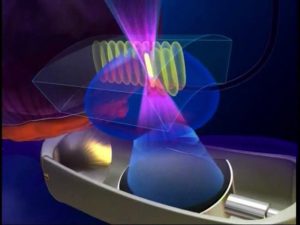
High Intensity Focused Ultrasound (HIFU) therapy for prostate cancer.
High Intensity Focused Ultrasound, or HIFU, is a minimally-invasive therapy that destroys prostate tissue with rapid heat elevation. Ultrasound energy, or sound waves, are focused on a specific area in the prostate to destroy cancerous cells. At the “focal point” of this energy, the temperature rises to almost 90 degrees Celsius (194 degrees Fahrenheit) in a matter of seconds. Any tissue at the focal point is destroyed; however, any tissue outside of the focal point remains unaffected. High Intensity Focused Ultrasound is only used as a therapy for prostate cancer when cancerous tissue remains inside the prostate capsule. This therapy is not suitable for cancer that has moved outside the prostate.
What are the advantages and disadvantages of HIFU?
The advantages of HIFU therapy include:
- No blood loss – this procedure does not require an incision.
- Quick recovery compared to major prostate surgery.
- Non-surgical, minimally-invasive procedure.
- Radiation free – it is designed not to damage adjacent tissue.
- High Intensity Focused Ultrasound is normally an outpatient procedure.
The disadvantages of HIFU therapy include:
- No long-term (20 – 30 years) outcome data available.
- Quality of life issues include a potential risk of impotence and/or urinary incontinence.
Preparing for HIFU treatment
7-10 days prior before treatment: All blood thinners including low dose aspirin must be discontinued seven to ten days prior to HIFU treatment due to the spinal anesthetic. In certain situations, additional blood work is required prior to treatment. The following medications must also be stopped prior to HIFU:
- Aspirin, including baby aspirin
- Plavix (Clopidogrel)
- Coumadin (Warfarin)
- Ticlid (Ticlopidine)
Certain herbal products and vitamins can also have blood thinning components, so it’s a good idea to discuss these products with your surgeon.
On the day before the procedure, the patient will have to perform bowel preparation at their home. Patients may have a light breakfast, followed by drinking clear fluids for the rest of the day. Patients are allowed to drink water until 2 hours before admission to their procedure.
At the hospital or surgery center, the patient will be given an enema, and will have additional testing if required, including: blood labs, ECG, and/or X-rays.
How is HIFU performed?
High Intensity Focused Ultrasound is performed under general anesthesia. After sedation, an ultrasound probe is placed into the rectum and the prostate is imaged. The urologist will map an outline of the prostate using ultrasound imaging to determine the areas of the prostate to be treated. The ultrasound probe is then used to focus high-intensity sound waves toward particular areas of the prostate determined to be cancerous. When treatment starts, 400 to 600 pulses of high intensity ultrasound are then administered to the prostate. This process is repeated, over the whole area of that prostatic tumor, until all of the cancerous tissue has been destroyed. On average, a patient will be in surgery between 2-4 hours.
Following treatment, a trans-urethral or supra-pubic catheter is left in place to allow the drainage of urine. The catheter will remain in place for three days to 2 weeks.
Following HIFU treatment
Treatment takes approximately two hours with recovery lasting another three to four hours. Patients may eat and drink as soon as you are awake. They will also be encouraged to get up and walk.
Patients will be given pain medication based on the amount of discomfort they are experiencing. Oftentimes, an over-the-counter product is adequate to control pain. A prescription for pain medication is provided, for use after discharge, if needed. Patients will be required to take an antibiotic, while using a catheter, to avoid the risk of a urinary tract infection.
Patients should pass urine with a good flow, good control, and no incontinence within a few days after having their catheter removed. Patients will then be provided with a prescription to reduce spasms which may occur for a short time after treatment. Sitting in a tub of warm water is also helpful for any pelvic cramping. Another medication, Flomax, can also be started a few days prior to the removal of the catheter to assist with voiding.
After HIFU treatment, the destroyed prostate tissue is passed out of the body during urination. It is common to see this sloughed material in the catheter bag. Patients may also see blood in their urine up to 12 weeks post treatment – this is a normal part of the healing process. The catheter will be removed by the Urologist during a post-surgical appointment.
High Intensity Focused Ultrasound treatment risks
As with any surgery, certain risks are involved. HIFU surgery may include the following risks to patients:
- Urinary incontinence
- Erectile dysfunction – Injury to the neurovascular bundle surrounding the prostate
- Urinary tract infection
- Urinary retention – due to swelling
- Urethral stricture – due to catheter placement; inflammation
Discuss all risks with your surgeon before making a decision to have High Intensity Focused Ultrasound therapy.
Dr. Eric Giesler performs the HIFU procedure. If you’re interested in learning more about HIFU therapy, schedule an appointment with Dr. Giesler.
Austin Monthly HIFU Interview
Dr. Giesler was featured in the April 2022 edition of Austin Monthly magazine. His interview was focused on High Intensity Focused Ultrasound as a treatment option for prostate cancer. Click below to read his interview: Outpatient Prostate Cancer Treatment Using HIFU Tissue Ablation. Article courtesy of Austin Monthly magazine.
HIFU Prostate Services_Austin Monthly April 2022
Related links
